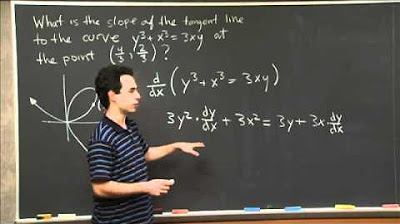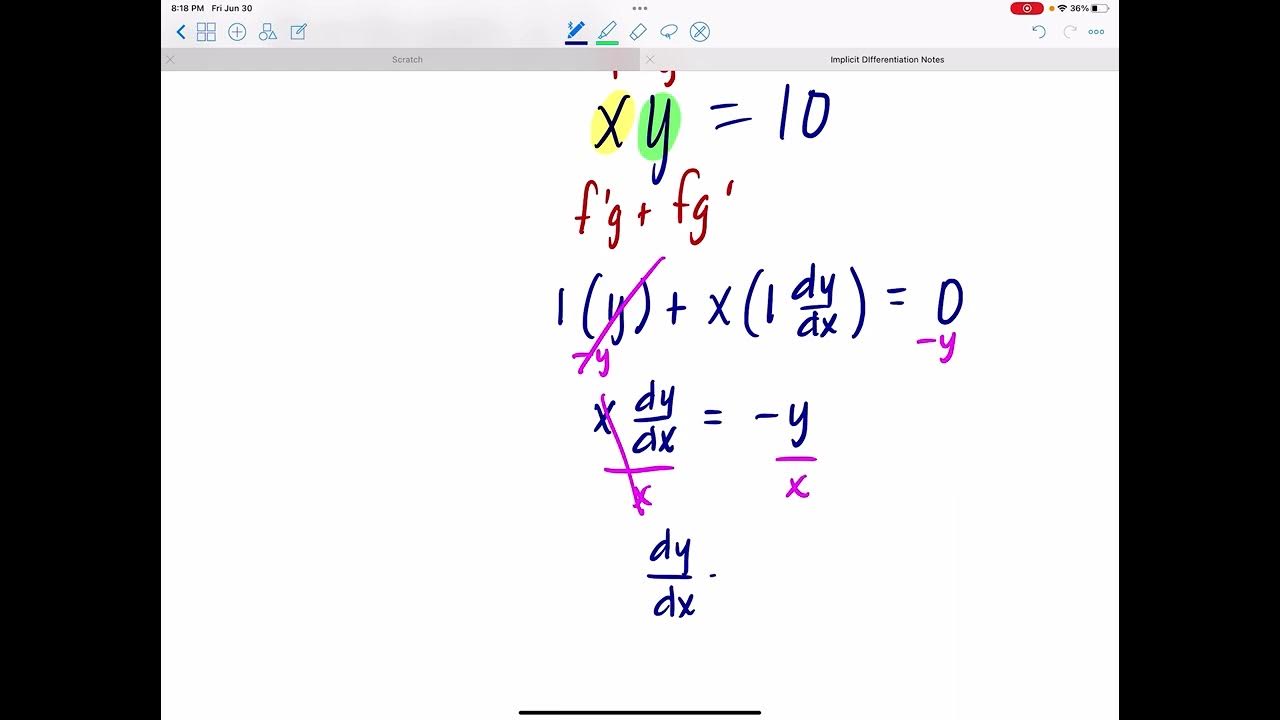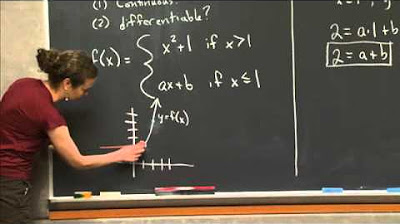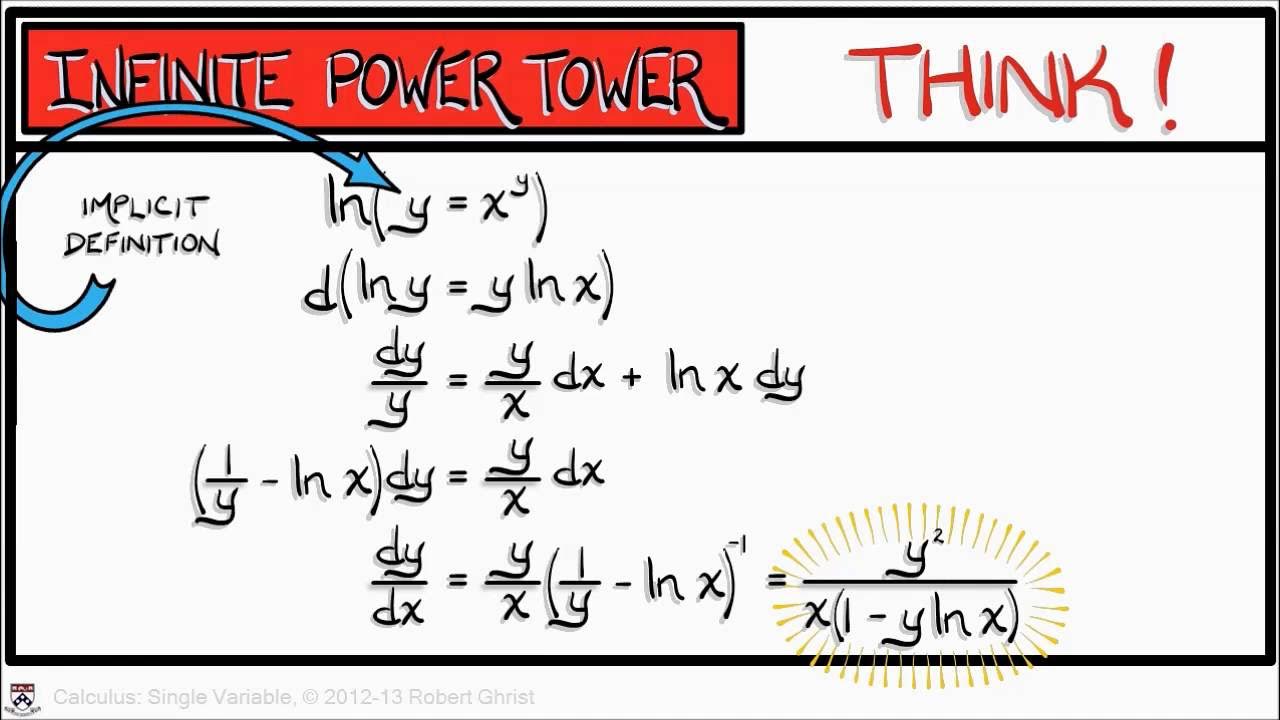Implicit Differentiation and Linear Approximation | MIT 18.01SC Single Variable Calculus, Fall 2010
TLDRIn this recitation, the professor discusses implicitly defined functions and implicit differentiation. They emphasize the importance of these concepts when functions can't be solved algebraically. Using an example function, w(x), defined implicitly, the professor demonstrates how to estimate values like w(3/2) through linear approximation. The process involves finding a base point and the derivative at that point using implicit differentiation. The professor walks through solving for the derivative and using it to approximate the function's value at a specific point, providing a practical application of the discussed concepts.
Takeaways
- 📚 The lecture focuses on implicitly defined functions and implicit differentiation.
- 🔍 Implicit differentiation is crucial when functions cannot be solved algebraically.
- ✏️ Example function: w(x) is defined implicitly by (w(x) + 1) * e^(w(x)) = x.
- 🧐 Some values, like w(0) = -1, can be guessed easily.
- 🤔 Others, like w(3/2), are difficult to compute algebraically and need numerical approximation.
- 📝 Linear approximation can estimate function values where explicit solutions are hard.
- 🔍 Example hint: w(1) = 0 helps base the linear approximation.
- 🔢 Linear approximation formula: w(x) ≈ w'(1) * (x - 1) + w(1).
- 📐 Derivative w'(x) is found using implicit differentiation.
- ⚖️ At x = 1, w'(1) = 1 / (w(1) + 2 * e^(w(1))) = 1/2.
- 🔢 Linear approximation near x = 1: w(x) ≈ 1/2 * (x - 1).
- 🔍 For x = 3/2, w(3/2) ≈ 1/4.
- 🔄 Iterating the process or using closer base points can refine the approximation.
- 💡 Implicit differentiation is used for computing derivatives in linear approximations.
Q & A
What is the main concept discussed in the lecture?
-The main concept discussed in the lecture is implicit differentiation and its importance when dealing with functions that cannot be expressed explicitly.
Why is implicit differentiation important?
-Implicit differentiation is important because it allows us to find the derivative of a function that is defined implicitly, which can be useful when there is no algebraic method to compute the function values as a formula.
What is the function w(x) defined by in the lecture?
-The function w(x) is defined implicitly by the equation w(x) + 1 times e to the power of w(x) equals x for all x.
How can you determine the value of w(0)?
-The value of w(0) can be determined by setting the right side of the equation to zero, which implies that w must be negative 1 to satisfy the equation.
What is the hint given by the professor to estimate w(3/2)?
-The hint given by the professor is that w(1) is 0, which can be used as a base point for the linear approximation to estimate w(3/2).
What is a linear approximation and how is it used in this context?
-A linear approximation is a method to estimate the value of a function near a certain point using a straight line that approximates the function's behavior. In this context, it is used to estimate w(3/2) when an explicit formula for w(x) is not available.
What are the two pieces of data needed to construct a linear approximation?
-The two pieces of data needed to construct a linear approximation are a base point and the derivative of the function at that base point.
How is the derivative of w(x) found using implicit differentiation?
-The derivative of w(x) is found by differentiating both sides of the implicit equation with respect to x, applying the product rule and the chain rule, and then solving for w'(x).
What is the value of w'(1) and how is it calculated?
-The value of w'(1) is 1/2. It is calculated by substituting x = 1 into the derived equation for w'(x) and using the known value of w(1) which is 0.
What is the estimated value of w(3/2) using the linear approximation?
-The estimated value of w(3/2) using the linear approximation is 1/4, which is obtained by substituting x = 3/2 into the linear approximation formula with w'(1) = 1/2.
How can a better estimate of w(3/2) be obtained?
-A better estimate of w(3/2) can be obtained by iterating the linear approximation process or by choosing a base point closer to x = 3/2 if the value of w at that point is known.
Outlines
📚 Introduction to Implicit Differentiation
The professor begins by introducing the concept of implicitly defined functions and the importance of implicit differentiation. An example function, w(x), is given, which cannot be solved algebraically for explicit values in some cases. The professor uses the function w(x) = e^(w(x)) - x to illustrate this and suggests that numerical approximations can be used to estimate values like w(3/2). The hint provided is that w(1) = 0, which will be used as a base point for the linear approximation. The task is to estimate w(3/2) using a linear approximation around the point (1, 0).
🔍 Applying Linear Approximation with Implicit Differentiation
The professor explains the process of linear approximation for estimating the value of w(3/2). The base point (1, 0) is established, and the need for the derivative of the function at that point is highlighted. Implicit differentiation is used to find the derivative of w with respect to x. The differentiation process involves applying the product rule and chain rule to the given equation. After simplifying, the derivative w'(x) is found to be 1 / (w(x) + 2 * e^(w(x))). The specific value of the derivative at x = 1, which is w'(1) = 1/2, is calculated using the known value of w(1) = 0. The linear approximation formula is then applied to estimate w(3/2) as 1/4, suggesting that a better estimate could be achieved by iterating the process or choosing a closer base point.
📘 Summary of Implicit Differentiation and Linear Approximation
The final paragraph wraps up the lesson by summarizing the steps taken to estimate the value of an implicitly defined function at a specific point. The process involved using implicit differentiation to find the derivative needed for the linear approximation formula. The professor emphasizes the normalcy of the linear approximation method, with the only unusual aspect being the necessity of implicit differentiation due to the inability to compute the derivative explicitly. The final value of the approximation for w(3/2) is reiterated, and the possibility of improving the estimate is briefly mentioned.
Mindmap
Keywords
💡Implicitly Defined Functions
💡Implicit Differentiation
💡Linear Approximation
💡Base Point
💡Numerical Approximation
💡Derivative
💡Product Rule
💡Chain Rule
💡Tangent Line
💡Estimation
💡Iterating
Highlights
Introduction to implicitly defined functions and the importance of implicit differentiation when algebraic methods fail.
Example of an implicitly defined function w(x) with the equation w(x) + 1 * e^(w(x)) = x, where direct computation of function values is not possible for some x.
Identification of easily computable function values, such as w(0) = -1, by logical deduction from the given equation.
Challenge of finding function values like w(3/2) without algebraic manipulation, emphasizing the need for numerical approximation methods.
Suggestion to use a linear approximation to estimate w(3/2) based on the function's behavior near a known point.
Hint provided: w(1) = 0, establishing a base point (1, 0) for the linear approximation.
Explanation of the linear approximation formula using a base point and the function's derivative at that point.
Process of implicit differentiation to find the derivative of w needed for the linear approximation.
Application of the product rule and chain rule during implicit differentiation of the given equation.
Solving the differentiated equation for w'(x) to find the derivative in terms of w(x) and e^(w(x)).
Substitution of x = 1 into the derivative equation to find the specific value of w'(1).
Use of the known value w(1) = 0 to simplify the calculation of w'(1), resulting in w'(1) = 1/2.
Substitution of w'(1) into the linear approximation formula to estimate w(x) near x = 1.
Estimation of w(3/2) using the linear approximation with the calculated derivative, resulting in an approximate value of 1/4.
Discussion on improving the estimate by iterating the process or choosing a base point closer to the point of interest.
Summary of the method used to estimate an implicitly defined function's value at a specific point using linear approximation and implicit differentiation.
Transcripts
Browse More Related Video

Worked example: Evaluating derivative with implicit differentiation | AP Calculus AB | Khan Academy

Implicit Differentiation | MIT 18.01SC Single Variable Calculus, Fall 2010

Implicit Differentiation

Implicit Differentiation

Smoothing a Piece-wise Function | MIT 18.01SC Single Variable Calculus, Fall 2010

Calculus Chapter 2 Lecture 16 BONUS
5.0 / 5 (0 votes)
Thanks for rating: